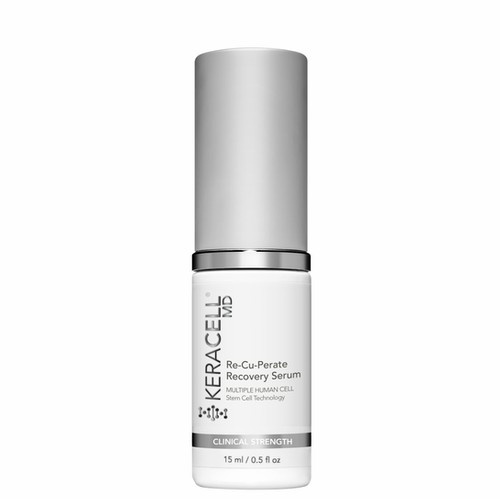
Re-Cu-Perate Recovery Serum With Mhcsc Technology
Highlights
Key Ingredients
Skim through
| Ingredient name | what-it-does | irr., com. | ID-Rating |
|---|---|---|---|
| Human Fibroblast/Mesenchymal Cell Conditioned Media | |||
| Water/Aqua | solvent | ||
| Copper Lysinate/Prolinate | cell-communicating ingredient | goodie | |
| TGF-b3 | |||
| Sodium Hyaluronate | skin-identical ingredient, moisturizer/humectant | 0, 0 | goodie |
| Methylglucoside Phosphate | cell-communicating ingredient | goodie | |
| Dehydroacetic Acid | preservative | ||
| Benzyl Alcohol | preservative, perfuming, solvent, viscosity controlling |
Keracell Re-Cu-Perate Recovery Serum With Mhcsc TechnologyIngredients explained

Good old water, aka H2O. The most common skincare ingredient of all. You can usually find it right in the very first spot of the ingredient list, meaning it’s the biggest thing out of all the stuff that makes up the product.
It’s mainly a solvent for ingredients that do not like to dissolve in oils but rather in water.
Once inside the skin, it hydrates, but not from the outside - putting pure water on the skin (hello long baths!) is drying.
One more thing: the water used in cosmetics is purified and deionized (it means that almost all of the mineral ions inside it is removed). Like this, the products can stay more stable over time.
An essential amino acid - mineral complex that is part of the pretty new anti-aging complex called Neodermyl. The manufacturer claims that the complex is able to boost skin's own collagen I and III as well as elastin production. Read more details at methylglucoside phosphate.

It’s the - sodium form - cousin of the famous NMF, hyaluronic acid (HA). If HA does not tell you anything we have a super detailed, geeky explanation about it here. The TL; DR version of HA is that it's a huge polymer (big molecule from repeated subunits) found in the skin that acts as a sponge helping the skin to hold onto water, being plump and elastic. HA is famous for its crazy water holding capacity as it can bind up to 1000 times its own weight in water.
As far as skincare goes, sodium hyaluronate and hyaluronic acid are pretty much the same and the two names are used interchangeably. As cosmetic chemist kindofstephen writes on reddit "sodium hyaluronate disassociates into hyaluronic acid molecule and a sodium atom in solution".
In spite of this, if you search for "hyaluronic acid vs sodium hyaluronate" you will find on multiple places that sodium hyaluronate is smaller and can penetrate the skin better. Chemically, this is definitely not true, as the two forms are almost the same, both are polymers and the subunits can be repeated in both forms as much as you like. (We also checked Prospector for sodium hyaluronate versions actually used in cosmetic products and found that the most common molecular weight was 1.5-1.8 million Da that absolutely counts as high molecular weight).
What seems to be a true difference, though, is that the salt form is more stable, easier to formulate and cheaper so it pops up more often on the ingredient lists.
If you wanna become a real HA-and-the-skin expert you can read way more about the topic at hyaluronic acid (including penetration-questions, differences between high and low molecular weight versions and a bunch of references to scientific literature).
It's a pretty new anti-aging ingredient that is a "safe and pre-activated source of energy to feed aging skin cells".
It's part of an anti-aging complex trade named Neodermyl, where methylglucoside phosphate is combined with the essential amino acids proline, lysine and also copper. This complex is claimed to be able to increase the collagen I and III production of skin and even more surprisingly, also the elastin production. Both slow down with age and beeing able to boost the skin's own production of these super important proteins results in improved skin firmness and elasticity.
This is a very big deal, especially the elastin part, as there is not yet a clinically proven active ingredient that is able to boost the skin's own elastin production. There are also very few ones (think vitamin C, glycolic acid, and retinol) that are proven to boost collagen. The claims about Neodermyl are not yet confirmed in independent studies but the manufacturer did do some very convincing testing that showed a visible reduction of wrinkle depth and volume in just 15 days. If you are into anti-aging, this is a new active that might be worth a try.
A helper ingredient that helps to make the products stay nice longer, aka preservative. It works mainly against fungi and has only milder effect against bacteria.
It is Ecocert and Cosmos approved, works quite well at low concentrations (0.1-0.6%) and is popular in natural products.
It's one of those things that help your cosmetics not to go wrong too soon, aka a preservative. It can be naturally found in fruits and teas but can also be made synthetically.
No matter the origin, in small amounts (up to 1%) it’s a nice, gentle preservative. Has to be combined with some other nice preservatives, like potassium sorbate to be broad spectrum enough.
In high amounts, it can be a skin irritant, but don’t worry, it’s never used in high amounts.
You may also want to take a look at...
| what‑it‑does | solvent |
| what‑it‑does | cell-communicating ingredient |
| what‑it‑does | skin-identical ingredient | moisturizer/humectant |
| irritancy, com. | 0, 0 |
| what‑it‑does | cell-communicating ingredient |
| what‑it‑does | preservative |
| what‑it‑does | preservative | perfuming | solvent | viscosity controlling |





